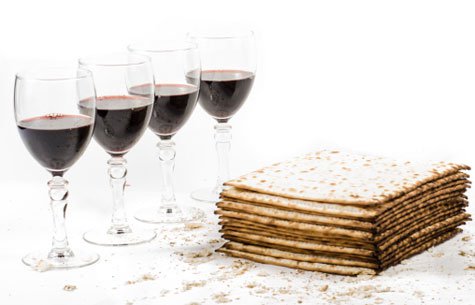
Reviewing my Pesach newsletters from the past two years had quite an impact on me. As we have moved past the Covid pandemic, it can be easy to forget the havoc it wreaked across the world for so long, along with its many victims – something which this chag should really teach us not to do. Learning from the past is an important aspect of our Weltanschauung and one that makes us better, stronger and more connected. If there was ever a time in which the Jewish people needed to be reminded of our historical unity, it is know! I am so happy to be seeing folks returning to having their sederim with large groups of family and friends but fervently hope that we remember the lessons of the past year(s) and continue to take pleasure in the simple enjoyment of close family and friends, while reaching out to assist our fellow Jews for whom the chag may not be as joyous for a host of reasons  .
.
As Pesach is a celebration of the Jewish people coming together a nation for the first time, this is an easy idea to get behind with everything we have got. Personally, I find choosing wine for our sedarim a worthy endeavor to apply some effort too, especially given the teaching by our sages that wine gladdens the heart and there is no joy without wine (and meat). With wine such an integral part of the Pesach holiday, physical and spiritual aspects combined, my hope is that this annual guide makes the task easier and hopefully helps in enhancing this year’s seder we are each about to undergo, regardless of our personal circumstances. Take the opportunity to recognize all you have and take some time to contemplate the nature of the holiday – it will serve to enhance things dramatically.
Now, with the philosophical messaging out of the way, onto wine!
Busy Times
Typically, the weeks leading up to Pesach are the US kosher wine industry’s busiest, with more kosher wine purchased during this period than the rest of the year combined (in Israel, Rosh Hashanah is nearly as busy a buying season as Pesach and wine buying is also more evenly spread throughout the year). Personally, purchasing wine for Pesach remains one of my favorite parts of Pesach prep, a feeling I am sure is shared by most committed wine lovers, and this year has yielded some new and exciting wines for every budget and palate preference. However, even though the more than 5,000 different kosher wines being produced annually includes more than 100 disparate varieties of unmentionable options like wines with Cream in their name, Manischewitz, variations of Yayin Patishim and of course the Blue Bottle Abomination, there remain far too many potentially valid options for any sane human being to wade through.
Elevated Stress Levels
 Each year we discuss the elevated stress levels brought on by cooking commercial amounts of restaurant-grade brisket and enough matza balls to feed Napoleon’s army while attempting to eradicate every speck of dirt from the inside of your oven with a toothbrush, with the hope that this Guide will eliminate wine choices as a potential area of stress. Despite its monumental importance, I feel very strongly that the wine selection process for your chag should as easy, stress-free and enjoyable as possible. That said, as most subscribers also use the guide throughout the year to assist with their regular wine shopping, we are including all the various usual components to assist in this endeavor as well.
Each year we discuss the elevated stress levels brought on by cooking commercial amounts of restaurant-grade brisket and enough matza balls to feed Napoleon’s army while attempting to eradicate every speck of dirt from the inside of your oven with a toothbrush, with the hope that this Guide will eliminate wine choices as a potential area of stress. Despite its monumental importance, I feel very strongly that the wine selection process for your chag should as easy, stress-free and enjoyable as possible. That said, as most subscribers also use the guide throughout the year to assist with their regular wine shopping, we are including all the various usual components to assist in this endeavor as well.
The hardest aspect of wine buying is the sheer (and ever-increasing) number of choices available to the consumer these days, as one contemplates the near-endless number of choices on the shelves or webpage of your favorite retailer. Without sufficient (and conflict-free) guidance, consumers are usually reduced to selecting wines based on the wine’s label, packaging (gift boxes for wine are a big incentive for some) or a more recent trend – uber heavy bottles for more popularly-priced wines, a guaranteed losing strategy. Exacerbating the issue are several additional mitigating circumstances, including the sheer number of mediocre-at-best available wines (along with an unacceptable amount of true dreck) and the unfortunate incentives leading many retailers to separate you from your hard-earned shekels by promoting these sometimes quite awful wines. While the level of knowledge within the kosher wine industry has grown tremendously over the last few years, the primary reason customers continue to leave stores with less than worthy options remain the lack of knowledge by those selling the wines, occasionally more sinister reasons are at play (e.g. “incentives”) so (as with all other shopping experiences) – caveat emptor. Other potential pitfalls to navigate is the aggravating inability of many retailers to accurately provide the vintage year of the offered wines and the classic “bait and switch” with an oenophilic twist – advertising great deals for highly allocated wines without having them in stock, and then trying to unload significantly inferior wines to unsuspecting consumers. Adding to the morass is the fact that many stores and online purveyors continue carry (and sell) wines so far past their drinking windows as to be criminal.
Help is Here
 With a desire to help reduce stress levels in any way I can, I have once again curated my Pesach Wine Buying Guide from among the thousands of available options. Hopefully the Guide will simplify your wine shopping and free you to spend time with the remainder of chag preparation, while having time to spend with your family and other loved ones.
With a desire to help reduce stress levels in any way I can, I have once again curated my Pesach Wine Buying Guide from among the thousands of available options. Hopefully the Guide will simplify your wine shopping and free you to spend time with the remainder of chag preparation, while having time to spend with your family and other loved ones.
As with most other retail experiences, inflation (and other factors) has continued to wreak havoc with pricing so, for the first time ever I have slightly moved the goal posts on the range of price tiers for The Guide (the number of wines over $200 is somewhat overwhelming). This year I have included my top recommendations for wines in the following five price tiers: (1) Under $20, (2) between $20-34.99, (3) between $35-54.99, (4) Over $55 and (5)  Moshiach Wines. As most of my readers know, Moshiach Wines are wines that I would proudly serve the Moshiach, were I ever sufficiently deserving for him to grace my Seder table.
Moshiach Wines. As most of my readers know, Moshiach Wines are wines that I would proudly serve the Moshiach, were I ever sufficiently deserving for him to grace my Seder table.
Many of the wines on this list will not come as a surprise to my regular readers given their perennial appearance over the years resulting from the consistent excellence of their producers and the talent of the applicable winemaker. As the quality and quantity of top-notch kosher wines continues to expand, the number of contenders for the Guide has increased exponentially, exacerbating the already difficult process of putting together this highly curated list (listing every single contender would defeat the entire purpose of creating the Guide). Representing less than 5% of all commercially available kosher wines, the list could serve to eliminate all stress involved in sifting through the menagerie of options. I am also making my regular plug for drinking more white wines. If you are one of those unfortunate and self-proclaimed “I don’t drink white wine” people, please take this as an opportunity to try something new – I promise you won’t be disappointed.
The Fine Print
As a corporate lawyer with over 20 years of deal-making under my belt, it shouldn’t surprise anyone that a list of this magnitude comes with some fine print and a few important caveats.
 1. The Guide isn’t intended to be a comprehensive list of every wine I believe worthy of your consideration. It represents a selection of the better wines available across different pricing tiers; each of which I recommend and believe worthy of your Pesach table. As I have written far less over the past year than ever before, I have included more wines than usual on the list to compensate. Of course, all wines remain subject to their recommended drinking window.
1. The Guide isn’t intended to be a comprehensive list of every wine I believe worthy of your consideration. It represents a selection of the better wines available across different pricing tiers; each of which I recommend and believe worthy of your Pesach table. As I have written far less over the past year than ever before, I have included more wines than usual on the list to compensate. Of course, all wines remain subject to their recommended drinking window.
2. Broadly speaking, most wines from Dalton, ElviWines, Flam, Gvaot, Herzog (in their Lineage & Special Reserve series) Recanati and Tzora are worth buying, even if they aren’t listed below.
3. With a few rare exceptions I didn’t repeat any wines listed in last year’s guide and many of last year’s wines are still available on the shelves and remain in top drinking condition so check out last year’s list for additional suggestions and/or vintages, as many of those are still available and drinking beautifully!
4. Some wines may only be available either in Israel or the US and I have tried to mark them as such. While there remain a number of wines that remain available only in their country of production (e.g. most winemaker “Pet Projects” in Israel, Four Gates and Shirah in the US and a number of French options in Europe), the vast majority of recommendable Israeli wines are imported to the US these days (Shmita excepting) and most of the Herzog/Royal wines that were formerly “US Only” wines, are exported to Israel, making this list more useful across the broadly disparate geographic location of my 11,000 subscribers.
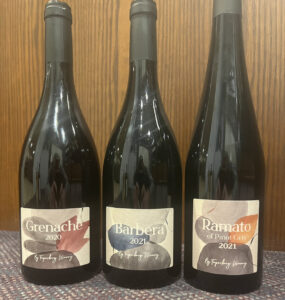 5. Due to the disparate geographical disbursement of my reader base, the listed vintages may be different depending on which part of the world your shopping cart is in (although vintages tend to also shift from local retailer to retailer and distributor to distributor, depending on how much of the prior vintage they have left in stock). Especially for Israeli wines, different vintages are available in Israel and outside of Israel.
5. Due to the disparate geographical disbursement of my reader base, the listed vintages may be different depending on which part of the world your shopping cart is in (although vintages tend to also shift from local retailer to retailer and distributor to distributor, depending on how much of the prior vintage they have left in stock). Especially for Israeli wines, different vintages are available in Israel and outside of Israel.
6. It is always best practice to consult me before buying a recommended wine from a different vintage but in this case, given the fluctuation in quality of recent vintages and potential shipping/storage issues, I’d be even more careful than usual when utilizing this list to purchase non-listed vintages.
7. As with most goods, wine prices have dramatically escalated over the last 12 months, so wines in each tier have often moved up to the more expensive slot. Additionally, prices fluctuate wildly from location to location, so when determining the price tier for each wine I typically average among several US online and brick and mortar options to achieve what is hopefully an average price for the various wines. However, listed wines in your local market may not always fall exactly within the listed price points (online price-checking is always a good idea, as is asking retailers to match listed prices).
Seder Drinking Conundrum
 Despite occupying a top spot on any oenophile’s list of favorite customs, the tradition to consume four full cups of wine at the Seder can be tricky to navigate, with a handful of potential issues requiring some thought. Thankfully, with a bit of thoughtful planning they can all be easily mitigated.
Despite occupying a top spot on any oenophile’s list of favorite customs, the tradition to consume four full cups of wine at the Seder can be tricky to navigate, with a handful of potential issues requiring some thought. Thankfully, with a bit of thoughtful planning they can all be easily mitigated.
First and foremost is that four full (or even partially full) cups of is a lot of wine to consume at one sitting, especially given the fact that the first two cups are typically imbibed on an empty stomach. Another issue stems from the tradition of using a silver goblet for Kiddush (and the rest of the cups). While the easy solution of pouring the wine into a proper wine glass immediately following the recital of Kiddush works beautifully on a regular Shabbat or chag, the lengthy Haggadah reading between pouring the wine and consuming it results in longer wine-silver contact that is advisable. Other potential issues include the (halachik driven) tradition of using only red wines and avoiding mevushal wines during the Seder.
With the Seder representing one of the most important meals on the Jewish calendar, people try to have the nicest (and often the correlatingly most expensive) wines possible, creating yet another potential conundrum. Despite being among the kosher wine world’s best, the in-store vintages of popular high(er)-end wines from Bordeaux, Italy, Spain, Israel and California are not yet ready to drink and unlikely to be properly appreciated giving the hurried manner in which most of the Seder’s four cups are mandated to be consumed. Many of the better wines are full-bodied, oak aged and boldly flavored; all attributes not very conducive to Seder drinking (even with extensive decanting). With the combination of the empty stomach with which most people approach the first two cups, the halachic requirement to consume nearly an entire cup of wine rather rapidly and the oft-additional stress from trying to corral hyperactive children; most Sedarim are unlikely to offer ideal conditions for enjoying such magnificent wines. That said, if your current circumstances allow for a leisurely seder enhanced by the finest wines in your cellar – go for it! Nothing elevates a meal like sharing a special and well-aged wine with friends and family and the spiritual aspects of wine sanctifying our table and seder-night experience would make using your best bottles to elevate the exalted experience as good a use of Moshiach wines as I can fathom.
The Perfect Solution
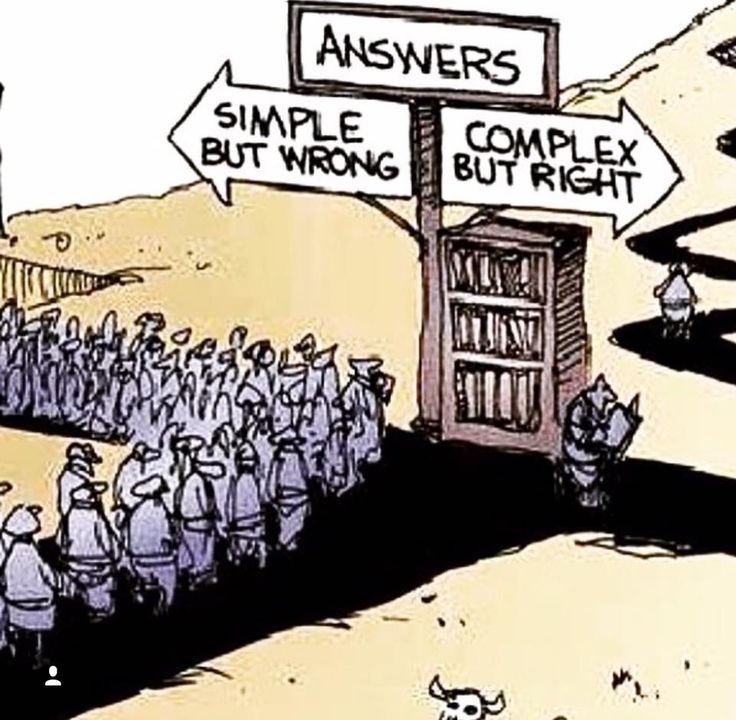 So, unless you are among the rarified company enjoying a seder conducive to such Moshiach wines, I suggest saving the more expensive wines for leisurely drinking during Shulchan Aruch and the plethora of subsequent holiday meals, while finding other worthy options for the Seder’s four cups. Being a traditionalist, my personal custom is to use red wines for all four cups, while selecting wines that fulfil a few basic criteria to ensure their enjoyment through the long Seder meal.
So, unless you are among the rarified company enjoying a seder conducive to such Moshiach wines, I suggest saving the more expensive wines for leisurely drinking during Shulchan Aruch and the plethora of subsequent holiday meals, while finding other worthy options for the Seder’s four cups. Being a traditionalist, my personal custom is to use red wines for all four cups, while selecting wines that fulfil a few basic criteria to ensure their enjoyment through the long Seder meal.
Over the last few years, the use of rose as a Seder wine has gained popularity. With color, relatively low acidity, affordability and a mass appeal, the option has a lot going for it. That said, I personally find it to be a simpler and more quaffable genre, lacking the necessary gravitas for such an exalted meal. Additionally, the quality of availability rose wines to have decreased (in a nearly correlative manner to its increasing popularity) to such a degree that recommending them as an appropriate genre doesn’t feel right to me.
Seder night is one of the most exalted evenings we get to spend in G-d’s company. It is an evening dedicated to celebrating our emancipation from historical slavery the coalescing of the Jewish People into a unified nation with collective responsibility for one another (a concept more important to remember these days than ever before). Given the importance of the evening, utilizing top-notch wine should remain a pre-requisite to proper execution of the Seder. The diverse and wide-ranging array of palate preferences around a typical seder table calls for a diverse range of wines. Coupled with the significant amount of wine to be consumed by the large gathering of family and friends, I focus on approachable, medium bodied quality wines that are enjoyable without the requirement of any level of oenophilic sophistication (or even appreciation). Over the years, my “go-to” Seder wines have included Israeli Petite Sirah from Vitkin and Recanati, entry-level Spanish & Italian wines from ElviWines and Terra di Seta respectively, well-priced Bordeaux, Mia Luce’s CSM blend and well-made Pinot Noir. To the extent you are looking for well-priced and versatile white (or Rosé), good bets will be rosé from Dalton or Hajdu; Sauvignon Blanc from Yarden, Covenant and Goose Bay, Pinot Grigio from Dalton or Yarden and Rieslings from Carmel, Kishor or Vitkin..
Parting Advice
During this busy buying season, retailers pull out all the stops to bring in your dollars with big sales everywhere. Between the increasing competition and online availability of most top-notch kosher wines, most wine merchants will match any published price, so always ask your favorite retailer to match the prices you have seen elsewhere and, if you aren’t happy with the price – ask for a discount.
With all the explanations behind us, I present my annual
Pesach Wine Buying Guide
Under $20
 Rising prices have somewhat decimated this list, with many previously well-priced options moving up to the next price point. However, there are still several good options on this list, each of which yields a good and enjoyable wines, albeit these wines aren’t complex or cellar worthy (with a few exceptions). With oak barrels representing a significant percentage of a wine’s cost (actual cost and the time-value of aging), many of these wines have spent little to no time in oak contributing to their lower prices. Along with focusing on “Safe Bet” wineries, more popular varieties like Cabernet Sauvignon, Merlot, Syrah and Chardonnay tend to be more expensive than their lessor known peers. Instead of reaching for the tried and true, seek out other varieties form the same winery or series which will usually be a bit cheaper. Suggestions include Barbera, Carignan, Cabernet Franc, Gewürztraminer, Grenache, Marselan, Petite Sirah, Petit Verdot, Roussanne, Sangiovese and Tempranillo.
Rising prices have somewhat decimated this list, with many previously well-priced options moving up to the next price point. However, there are still several good options on this list, each of which yields a good and enjoyable wines, albeit these wines aren’t complex or cellar worthy (with a few exceptions). With oak barrels representing a significant percentage of a wine’s cost (actual cost and the time-value of aging), many of these wines have spent little to no time in oak contributing to their lower prices. Along with focusing on “Safe Bet” wineries, more popular varieties like Cabernet Sauvignon, Merlot, Syrah and Chardonnay tend to be more expensive than their lessor known peers. Instead of reaching for the tried and true, seek out other varieties form the same winery or series which will usually be a bit cheaper. Suggestions include Barbera, Carignan, Cabernet Franc, Gewürztraminer, Grenache, Marselan, Petite Sirah, Petit Verdot, Roussanne, Sangiovese and Tempranillo.
-
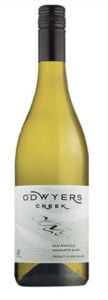 Cantina Giuliano, Vermentino, 2021
Cantina Giuliano, Vermentino, 2021- Cellar de Capçanes, Peraj Petita, Rosat, 2022
- Château les Riganes, Red, Bordeaux, 2021 [mevushal]
- Covenant, Mensch, Zinfandel, 2022 [mevushal]
- Dalton, Pinot Grigio, 2022
- ElviWines, Herenza, Rioja (Semi-Crienza), 2020 (white/blue label) [mevushal]
- ElviWines, Herenza, White, 2021 (f/k/a InVita)
- ElviWines, Vina Encina, White, 2020 [mevushal]
- Golan Heights Winery, Yarden, Sauvignon Blanc, 2021 (also 2021 Hermon Indigo)
- Herzog, Baron Herzog, Cabernet Sauvignon, 2020 [mevushal]
- Herzog, Lineage, Sauvignon Blanc, 2022 [mevushal]
- Koenig, Riesling, Alsace, 2020 [mevushal]
- O’Dwyers Creek, Sauvignon Blanc, 2021 [mevushal]
- Pacifica, Viognier, 2020 [mevushal]
- Ramon Cardova, Rioja, 2019 [mevushal]
- Recanati, Colombard, 2022 (also 2022 Carignan) [Israel]
- Recanati, Yasmin, White, 2022 [mevushal]
- Terra di Seta, Chianti Classico, 2020
$20 – $24.99
As the average price of a quality bottle of kosher wine continues to surge (this tier absorbed a fair number of wines previously in the under $18 range), it’s refreshing to find several wineries valiantly trying to hold their ground at affordable. While most great wines cost more than $30, there are plenty of good ones here as well. In general, I find Carmel, Dalton, ElviWines, the Golan Heights Winery and Recanati to be consistent players in price range.
-
- Ari Earle Wines, Dabuki, White, 2022 (Bat-Shlomo’s winemaker) (also 2022 Dabuki Barrel [Israel])
- Bat-Shlomo, Sauvignon Blanc, 2022 (also 2021 Chardonnay)
- By Teperberg, Barbera, 2021 (Ast. Winemaker Dani Friedenberg wine) (also 2020 Grenache) [Israel]
- Carmel, 4 Vats, Mediterranean, Shomron, 2021
- Carmel, Appellation, Petite Verdot, 2018 (also Cab. Sauvignon/Shiraz 2018) [both mevushal]
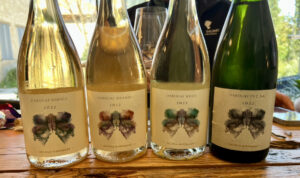 Château D’Arveyres, Bordeaux, 2019 [mevushal]
Château D’Arveyres, Bordeaux, 2019 [mevushal]- Château Forcas Dupre, Listrac Medoc, 2020
- Château Lamothe-Cissac Haut-Médoc, 2019
- Château Meilhan, Medoc, 2020 [US]
- Château Royaumont, Lalande de Pomerol, 2019
- Christophe Patrice, Gendraud Patrice, Chablis, 2020 [US]
- Covenant, Landsman, Pinot Noir, 2021
- Covenant, Red C, Rose, 2022 (also 2022 Viognier)
- Covenant, The Tribe, Chardonnay, 2021 (also 2022 Red C Sauvignon Blanc)
- Dalton, Alma, Rose, 2022
- Dalton, Asufa, Coast to Coast, 2019
- Dalton, Reserve, Sauvignon Blanc, 2021
- Domaine du Haut-Montlong Les Hauts des Noilettes, Vieilles Vignes, Monbazillac, 2020 [US]
- Domaine Guillerault Fargette, Sancerre, 2020
- Drimia, Sauvignon Blanc, 2021 [Israel]
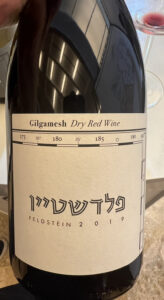 ElviWines, Cava, Brut, N.V.
ElviWines, Cava, Brut, N.V.- ElviWines, Herenza, Rioja (Crianza), 2018 (Black Label)
- Feldstein, Dabuki, 2022 (also 2021 Roussanne) [Israel]
- Feldstein, Gilgamesh, 2019 [Israel]
- Feudi del Pisciotto, Merlot, Sicily, 2019
- Five Stones, D V G, White, 2022 (also 2022 Rose)
- Flam, Classico, 2021
- Golan Heights Winery, Gilgal (Gamla), Brut, N.V.
- Golan Heights Winery, Yarden, Syrah, 2019
- Goose Bay, Pinot Grigio, 2022 (also 2021 Chardonnay) [mevushal]
- Goose Bay, Sauvignon Blanc, 2021 [mevushal]
- Gush Etzion, Lone Oak, Viognier, 2021 (also 2019 Cabernet Franc)
- Gush Etzion, Spring Valley, GSM, 2021
- Hagafen, Pinot Noir, Coombsville, 2021 [mevushal]
- Hajdu, Pinot Blanc, 2022 [US]
 Herzberg, Village, 2020 (also Reserve 2021)
Herzberg, Village, 2020 (also Reserve 2021)- Herzog, Special Reserve, Cabernet Sauvignon, Alexander Valley, 2020 (also 2020 Napa) [mevushal]
- Herzog, Variations, Cabernet Sauvignon, Five, 2020 (also 2020 American Oak) [mevushal]
- Invei, Malbec, Rose, 2021 [US]
- K Syrah, by Zev Dunie, Syrah, 2019 [Israel]
- Matar, Stratus, 2019
- Pescaja, Solei Terre Alfieri, Arneis, 2021
- Pinto, Rose, 2022 (also the 2021 White Sands) [both Israel]
- Psagot, Sauvignon Blanc, 2020 (also Viognier)
- Psagot, Sinai, Red, 2021 [mevushal]
- Ramon Cardova Albarino, 2020
- Recanati, Gris de Marselan, Rose, 2022
- Recanati, Single Vineyard, Chardonnay, Manara, 2020
- Segal, Beta, Rose, 2022 (also 2022 “Other Red”) [both Israel]
- Segal, Wild Fermentation, Chardonnay, 2019 (also 2019 Native Marawi)
- Sheldrake Point, Dry Riesling, Finger Lakes, 2021
- Shiloh, Legend, Fiddler, 2020 (also 2020 Privilege) [both mevushal]
- Shiloh, Shor, Merlot, 2020 [mevushal]
- Shirah, One | Two Punch, 2019
- Shiv’im, Red, 2020 [Israel]
- Tabor, Single Vineyard, Marselan, 2019
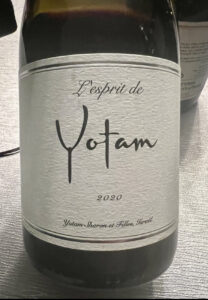 Teperberg, Essence, Cabernet Sauvignon, 2018
Teperberg, Essence, Cabernet Sauvignon, 2018- Teperberg, Essence, Pinot Gris, 2021 [Israel]
- Terra di Seta, Chianti Classico, Riserva, 2018
- Tinazzi, Desto, Cabernet Sauvignon, Costa Vento, 2018 [US / mevushal]
- Tura, Ridge, 2021
- Twin Suns, Reserve, Cabernet Sauvignon, 2021 [US / mevushal]
- Tzuba, Chardonnay, 2019
- Vitkin, Israel Journey, White, 2021 (also 2022 Rose)
- Weinstock, Cellar Select, Cabernet Sauvignon, Paso, 2020 [mevushal]
- YA Winery, by Yossi Ashkenazi, Kerem Ben Zimra, Sauvignon Blanc, 2021
- Ya’acov Oryah, Light from Darkness, 2022
- Yaffo, Hommage (Reserve), Malbec, 2021
- Yaffo, Hommage (Reserve), Viognier, 2021 (also 2021 Chardonnay)
- Yatir, Darom, White, 2021
- Yatir, Mount Amsa, White, 2020
- Yotam Sharon Wines, L’esprit de Yotam, Red, 2020 (also 2021 Cuvee Vera)
$35 – $55

While a lot of good options sit in this category, many of them really should be priced in the lower range but have crept up in price for no justifiable reason. It’s harder to sell wines in this price range than the one above or below it. It’s also nearly impossible to find a YH Best Buy on this list. As with most higher-end wines, especially those with a year or more of barrel aging, these need time to open (often the current vintage should be regulated to a few years of aging since it simply isn’t ready for primetime). In any event, do yourself a favor and get a decanter to ensure that you are obtaining maximum benefit from these wines if you don’t or cannot cellar them before enjoying.
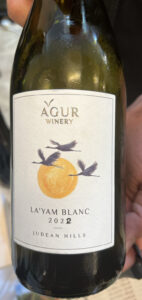
-
-
- Agur, Layam, Blanc, 2022
- Bat-Shlomo, Regavim, 2019
- Carmel, Mediterranean, 2019
- Cellar de Capçanes, La Flor del Flor de Primavera, Samso, 2017
- Cellar de Capçanes, Peraj Ha’Abib, Montsant, 2021 [mevushal]
- Champagne Bonnet-Ponson, Brut, n.v. [US]
- Champagne Drappier, Brut Nature, Zero Dosage, Rose, N.V.
- Champagne Drappier, Carte D’ Or, Brut, N.V.
- Château Guiraud, G, 2019 (Dry)
- Château Hautville, Saint-Estephe, 2021
- Château Rollan de By, Medoc, 2019 [mevushal]
- Château Tour Seran, Medoc, 2019 [mevushal]
- Covenant, Lavan, Chardonnay, 2021
- Flam, White, 2022 (white label; different than the Flam Blanc)
- Golan Heights Winery, Yarden, 2T, 2019
- Golan Heights Winery, Yarden, Brut, Rose, 2016
 Gvaot, Dances in White, 2022 (also 2022 Rose)
Gvaot, Dances in White, 2022 (also 2022 Rose)- Gvaot, Gofna Reserve, Cabernet Sauvignon, 2020
- Hagafen, Merlot, Napa Valley, 2018 [mevushal]
- Hagafen, Prix Reserve, Merlot, 2018 [mevushal]
- Hagafen, Prix Reserve, Sauvignon Blanc, 2018 (also the 2018 Syrah) [both mevushal]
- Hajdu, Barbera, 2021 (also 2021 Tannat) [US]
- Herzog, Special Edition, Chardonnay, Chalk Hill, 2021 [mevushal]
- Herzog, Special Reserve, Quartet, 2020 (also 2020 Lake County) [both mevushal]
- J. De Villebois, Sancerre, Silex, 2021 [US]
- Jean Marc Brun Bourgogne Hautes-Cotes de Nuits, 2021 [US]
- Jean-Paul Seguin, Sancerre, Cuvee Tradition, 2020 [US]
- Jean-Pierre Bailly, Pouilly-Fume, 2021 [US]
- Kishor Vineyards, GSM, 2020 (also 2021 Mourvèdre)
- Kishor Vineyards, Riesling, 2021 [Israel]
- Kishor Vineyards, White Kishor, 2022
- L’enclos, Vin Rouge Sec, 2020 (personal wine by Olivier Fratty – Barkan’s new head winemaker) [Israel]
- Les Marrionniers, Chablis, 2021 [mevushal] (also the 2020 Premier Cru)
- Les Roches de Yon-Figeac, Saint-Émilion, 2020
- Midbar, Grenache, 2020 [Israel]
- Netofa, Latour, White, 2020
- Netofa, Tel Qasser, Red, 2019 (also 2019 White)
 Pe’er Winery, Black Sheep, Red Blend, 2019 [Israel]
Pe’er Winery, Black Sheep, Red Blend, 2019 [Israel]- Pescaja, Soliter, Barbera d’Asti, 2020 [US]
- Recanati, Mediterranean Reserve, Wild Carignan, 2020 (also 2020 Petite Sirah)
- Rocca di Frassinello, Le Sughere di Frassinello, Toscana, 2020 [US]
- Segal, Whole Cluster, Pinot Noir, 2018
- Shiloh, Secret Reserve, Petite Sirah, 2019 [mevushal] (also Merlot 2019)
- Shirah, Coalition, 2019
- Shiran, Semillon, 2021 (also the 2020 Soprano)
- Shiran, The Song of the Birds, 2020
- Stoudemire, Reserve, Cabernet Sauvignon, 2019
- Terra di Seta, Chianti Classico, Gran Selezione, Assai, 2016
- Tzora, Judean Hills, White, 2021
- Tzora, Shoresh, Red, 2021 (also 2021 Shoresh White)
- Vitkin, Carignan, 2019 (also 2019 Petite Sirah & 2020 Pinot Noir)
- Vitkin, Collector’s Edition, Grenache Blanc, 2020
- Vitkin, Collector’s Edition, Grenache Noir, 2019 [Israel]
- Ya’acov Oryah, Alpha Omega, SMLH Viognier, 2021(also 2021 Gewürztraminer)
- Ya’acov Oryah, Black Pinecone, Pinot Noir, 2019 [Israel]
- Ya’acov Oryah, Valley of the Hunters, 2017 [Israel]
-
Over $55
Over the decade of producing the Guide, many deserving wines were repeatedly excluded because they were priced over $50 and didn’t quite make the exalted “Moshiach Wine” club. Whether any particular wine is “worth it” is a subjective matter with a newsletter all to itself, these are great wines that will bring great pleasure while properly honoring your Pesach experience. Even more than the prior tier, proper aeration and cellaring will have a huge impact of extracting maximum pleasure from these wines.
-
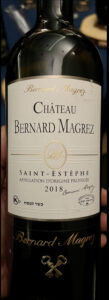 Bat-Shlomo, Winemaker’s Collection, Collage, 2020
Bat-Shlomo, Winemaker’s Collection, Collage, 2020- Bernard Magrez, Servitude de la Tour Carnet, Haut-Medoc, 2017 [US]
- Castel, Raziel, 2019 (also the Raziel Sparkling Rose)
- Château Angelus Carillon de l’Angélus, 2020
- Château Bellefont Belcier, Saint Emilion, 2020
- Château Bernard Magrez, Saint-Estephe, 2018 [US]
- Château Clarke, Baron Edmond de Rothschild, Listrac-Medoc, 2020
- Château Clement-Pichon, Haut-Medoc, 2020
- Château Fayat, Pomerol, 2020
- Château Haut-Breton Larigaudiere, Margaux, 2019
- Château Kirwan, Margaux, 2018 [US]
- Château Le Crock, Saint-Estephe, 2020 [mevushal]
- Château Leoville de Poyferre, Pavillon de Leoville Poyferre, Saint Julien, 2020
- Château Luchey-Halde, “S”, Pessac-Leognan, 2016 [US]
- Château Malartic Lagraviere, Pessac-Leognan, Blanc, 2020
- Château , Margaux, 2019
- Château Meyney, Saint-Estèphe, 2020
- Château Montviel, Pomerol, 2020
- Château Olivier, Pessac-Leognan, 2020
- Château Piada, Sauternes, 2020
- Château Sainte Marguerite, Cuvee Symphonie, Blanc, Cotes de Provence, 2021
- Covenant, Cabernet Sauvignon, 2020 (also 2020 Syrah)
 Covenant, Solomon, Sauvignon Blanc, 2020
Covenant, Solomon, Sauvignon Blanc, 2020- Domaine Aegerter, Volnay, 2020 [US]
- Domaine du Chateau Philippe le Hardi, Beaune, 2020
- Domaine de Chevalier, L’esprit de Chevalier, Graves, 2019
- ElviWines, Herenza, Rioja, Reserva, 2016 (also EL 26 2019)
- Golan Heights Winery, Yarden, Single Vineyard, Syrah, Bar’on, 2019
- Gvaot, Masada, 2020
- Herzog, Special Edition, Cabernet Sauvignon, Chalk Hill, 2019
- Jean-Philippe Marchand, Gevrey-Chambertin, 2019 (also 2019 Volnay)
- Jean-Philippe Marchand, Meursault, 2021
- Lueria, Gran Vital, 2018
- Mia Luce, CSM, 2020
- Shiran, Limited Edition, Carignan, 2020 (also the Limited Edition Tempranillo)
- Teperberg, Legacy, Cabernet Franc, 2018 (also 2018 Petite Sirah)
- Tzora, Misty Hills, 2019
- Valle Reale, San Calisto, Montepulciano D’Abruzzo, 2018
- Vignobles Mayard Le Hurlevent, Châteauneuf-du-Pape, 2020
- Yatir, Forest, 2019
 Moshiach wines are the really special wines that represent top-notch winemaking and plenty of patience on the consumer’s part to allow the wines the additional aging time in the bottle before the wine showcases all it can be (and the perfection intended by the winemaker). The word is derived from the fact that I’d be proud to serve these wines to the Moshiach were I ever so lucky as to have him grace my [Seder] table. Unfortunately, as our world continues to devolve into the pursuit for instant gratification, the terrible crime of consuming high-end wines shortly after they are purchased is a crying shame. While certain top tier wines are structured for immediate consumption and long-term aging, a few years of aging nearly always does good things for these wines and is worth the extra time, effort and patience. With the continued global expansion of my Rosh Chodesh Club concept (over 30 regular monthly meetings worldwide), more and more folks and getting to experience the immense pleasure derived from properly aged mature wines and with the recognition that a few years of storage can yield a stratospheric ROI, many more wines are finding their way to the cellar instead of the table upon purchase – which is a great thing!
Moshiach wines are the really special wines that represent top-notch winemaking and plenty of patience on the consumer’s part to allow the wines the additional aging time in the bottle before the wine showcases all it can be (and the perfection intended by the winemaker). The word is derived from the fact that I’d be proud to serve these wines to the Moshiach were I ever so lucky as to have him grace my [Seder] table. Unfortunately, as our world continues to devolve into the pursuit for instant gratification, the terrible crime of consuming high-end wines shortly after they are purchased is a crying shame. While certain top tier wines are structured for immediate consumption and long-term aging, a few years of aging nearly always does good things for these wines and is worth the extra time, effort and patience. With the continued global expansion of my Rosh Chodesh Club concept (over 30 regular monthly meetings worldwide), more and more folks and getting to experience the immense pleasure derived from properly aged mature wines and with the recognition that a few years of storage can yield a stratospheric ROI, many more wines are finding their way to the cellar instead of the table upon purchase – which is a great thing!
Please note that some of the Moshiach wines are very limited-edition wines that may not be easily available at your local retailer. While they may be a tad difficult to lay your hands on, I promise they are all worth the extra effort and additional expense. Additionally, and as is the case with many of the best wines, many become Moshiach wines only after a few years of aging. As older vintages (that have been stored properly) are somewhat difficult to come by the list includes the current vintage for many of the wines and, for a few the wines I have included (at least one of) the vintages that makes the wine fit for the Moshiach (buy the current vintages, store them properly for a few years and voila – house-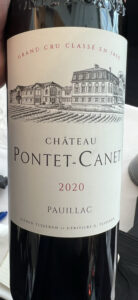 Moshiach wines).
Moshiach wines).
-
-
- Château Cantenac Brown, 2018 (2015)
- Château Giscours, Margaux, 2020 (2003)
- Château Lafon Rochet, Saint-Estèphe, 2020 (2003, 2010)
- Château Lascombes, Margaux, 2020 (2015)
- Château Léoville Poyferré, Saint Julien, 2020 (2000, 2005)
- Château Malartic Lagraviere, Pessac-Léognan, 2020 (2005)
- Château Pape Clement, Pessac-Leognan, 2017 (2014) [US]
- Château Pontet-Canet, Pauillac, 2020 (2003)
- Château Smith Haut Lafitte, Pessac-Léognan, 2019 (2009, 2014)
- Covenant, Lot 70, Solomon, Cabernet Sauvignon, 2019 (2011)
- Domaine Aegerter, Meursault, 2020 [US]
- Domaine de Montille, Pommard, Les Grands Epenots, 2020 (also Volnay & Puligny-Montrachet) [US]
- Domaine Roses Camille, Pomerol, 2015 (2005, 2011) [US]
- ElviWines, Clos Mesorah, 2019 (2010)
- Four Gates, Chardonnay, 2018 (2007, 2011) [US]
- Hajdu, Proprietary Red, 2020 (2010) [US]
- Herzog, Generation IX, Cabernet Sauvignon, Stags Leap, 2020 (2018)
- Herzog, Special Reserve, Cabernet Sauvignon, Clone Six, 2019 (2011)
- Marciano, Marciano Estate, Cabernet Sauvignon, 20202 [US]
- Yaacov Oryah, Old Musketeer, Sweet White Wine, 2008 (Ten Year Release) [Israel / Shmita]
-